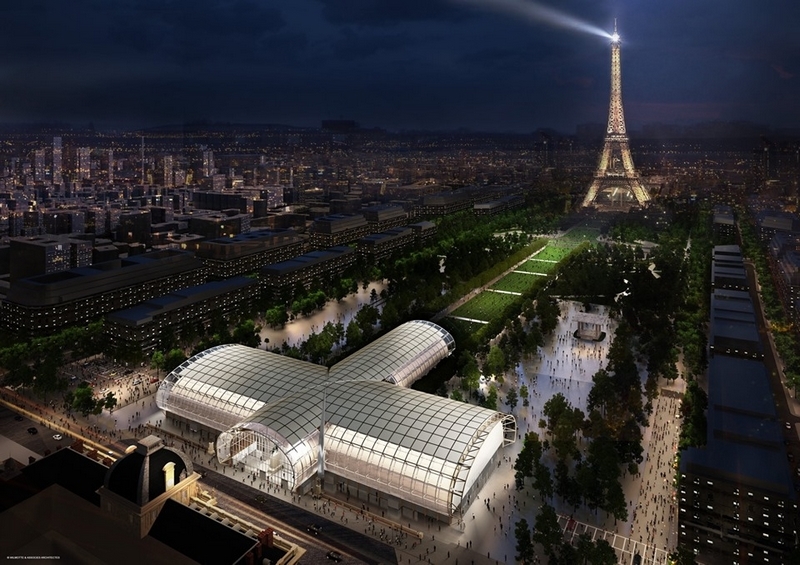
FIAC The Grand Palais Éphémère – FIAC’s new home in 2021-2022; Image: ©Wilmotte & Associés Architectes⠀
“If our generation did not reinvigorate the French art market, what would we be leaving to the younger people?” asks Jennifer Flay, director of the international fair of contemporary art in Paris. “So we decided to take ourselves seriously.”
As the 46th Foire internationale d’art contemporain (FIAC) prepares to open the doors of the Grand Palais this week, it is clear that not only did Flay and her colleagues achieve their goal, but they also created an environment in which artists and their work could flourish. The fair has gone from dusty irrelevance during a long sojourn in the suburbs to a glittering fixture on the art world calendar.
London galleries are launching new spaces in Paris, and US dealerships, who would once have chosen London as their European base, are going to Paris instead. Is it the Brexit effect? The Macron effect? Or is it simply that with a revitalised art fair rivalling Frieze for international clout, a vibrant gallery scene, a growing number of serious young collectors and world-class museums, Paris is having a moment?
In February 2018 the Los Angeles gallery Freedman Fitzpatrick opened a second space near the Hotel de Ville because, says its co-director Robbie Fitzpatrick, “over four years exhibiting at FIAC we realised we were making our highest number of sales outside the US in France, both to private collectors and institutions”.
They are not the only ones. On Wednesday, FIAC’s preview day and private viewing, David Zwirner inaugurates his first continental outpost in the 8,600sq ft space once occupied by the famed French gallerist Yvon Lambert. Meanwhile, White Cube has announced it will open offices and a viewing room on Avenue Matignon early next year, and rumour has it that Pace Gallery and Hauser & Wirth are “looking”. Neither will confirm or deny this, but both sent ambiguous emails when asked. “As always, we would need the perfect combination of the right strategy, opportunity and passion,” wrote Iwan Wirth. “Ultimately, we remain completely committed to being embedded in London’s vibrant cultural scene; that will not change.”
Tova Ossad, who founded the consultancy Ossad Art Management this year, does not think Paris will replace London. “I don’t see it. There’s too much to unravel. London’s roots are too deep, and it is so international – you have Asia, the US and the Middle East. But galleries that identify as European may want to open there. And that’s good for us both – two thriving markets working together.”
All the galleries coming from London emphasise its significance as a global art hub and while most concede that Brexit is a factor in their move across the Channel, it is not the only reason.

Mathieu Paris, senior director of White Cube in London for the past six years, is returning to his native city to run the new space. “This is absolutely not an emergency solution to the political situation,” he says. “The fact is that for the last seven years Paris has been back on the map.
“It was always a city for artists and collectors but there was a decline after the second world war. You can really feel its renaissance now and we want to tap into the French tradition of the marchand d’art, showing great masterpieces in an intimate, discreet way from a beautiful Haussmann apartment in a prestigious area.”
This sounds like the antithesis of the pared-down Young British Artist movement of 1990s London from which White Cube emerged, its owner, Jay Jopling, the preeminent YBA dealer. Not so, says Tracey Emin, who lives in France for some of the year and has a studio there. “Jay only has two YBA artists now – me and Damien [Hirst]. Opening a space in Paris is a way of changing perceptions and expressing the gallery’s identity.”
German-born Zwirner has said that identity is central to his decision, telling the Financial Times: “Brexit changes the game. After October my London gallery will be a British gallery, not a European one. I am European, and I would like a European gallery too.”
Glenn Scott-Wright’s assertion that in these times of uncertainty “everybody needs a European base” seems to be the general consensus. Scott-Wright, co-director of Victoria Miro Gallery, says he sees “a definite shift towards Paris”.
“French auction houses have a more serious presence on the contemporary scene than before, and [François] Pinault and [Bernard] Arnault are hugely influential,” he says of the magnates and collectors.
Paris’s fashion and luxury-goods houses are intrinsic to the art scene. There is huge excitement over the “home-coming” of Pinault whose two magnificent Venice art spaces look set to be eclipsed by his $170m contemporary art museum set to open in Paris next June. Fondation Cartier’s move to the Louvre des Antiquaires building opposite the Louvre, in 2024, will transform a dreary tourist parade into a booming contemporary art centre. And Arnault’s Fondation Louis Vuitton has produced a stunning run of exhibitions over the past four years.
“Louis Vuitton’s sponsorship of Yayoi Kusama’s retrospective [Tate Modern in London, the Whitney in New York, Museo Nacional Centro de Art Reina Sofía in Madrid, and the Pompidou in Paris] helped to make her a household name with a broader non-art world audience,” adds Scott-Wright.
As part of FIAC’s Hors les Murs programme which places outdoor artworks in public spaces, Victoria Miro has collaborated with David Zwirner and Ota Fine Arts to commission a vast Kusama installation for Place Vendôme. “Kusama says no to an awful lot,” says Scott-Wright, “but she couldn’t say no to this. Paris holds tremendous allure for artists.”
Emin agrees. “It’s an antidote to everything we don’t like in the world right now: the beauty of the city, the fact that you walk everywhere; it feels artisanal, a place to reclaim your soul.”
guardian.co.uk © Guardian News & Media Limited 2010
Published via the Guardian News Feed plugin for WordPress.

